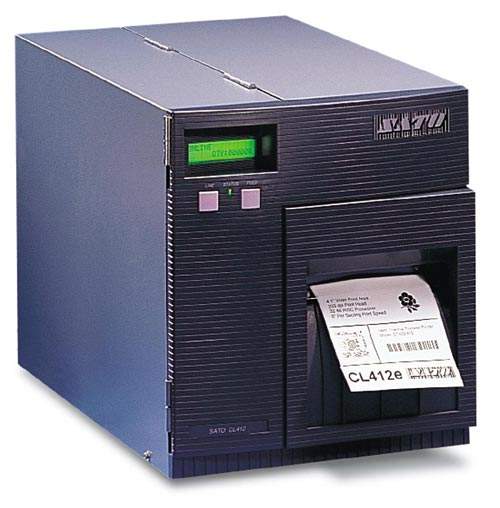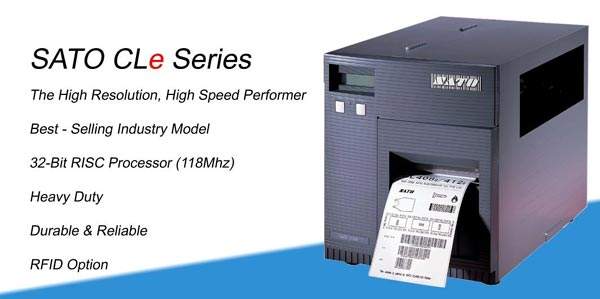In February 2005, Nestlé began installation of an RFID-augmented automated pallet labelling system. The Swiss company incorporated the technology, because leading retailers, including the German Metro Group, demand that manufacturers who provide them have the tracking solution installed. Nestlé believe that the UHF RFID (radio frequency identification) tags enable significant savings to be made in the supply chain and enable the cost-efficient tracking of pallets of goods.
SATO, in collaboration with UPM Rafsec, studied Nestlé’s requirements thoroughly before designing and installing a solution. The traceability solution applies to prospective shipping label applications in the market. The first of Nestle’s new automatic pallet-labelling units became operational at the company’s distribution centre in Rangsdorf earlier this year.
TECHNOLOGY FOR NOW AND FOR THE FUTURE
The automatic pallet labelling solution incorporates “Flag Tag” – a feature that allows Nestlé to tag all pallets with one type of tag. The technology also allows for other shipping labelling solutions available in the market.
The retail industry is adopting RFID technology as the natural replacement of the current bar code-based tracking systems as RFID tags automatically track inventory through the supply chain. In addition, when compared to the existing bar code-based systems, RFID automatic data collection is far more practical.
The tags do not require line of sight or manual scanning and the information can be accessed automatically using fixed, mobile or handheld readers unlike individual bar code scanning. The tags can be tracked through paint and non-metallic packaging as radio waves are used to interpret the transponder. It is a faster system that enables tracking several different labels at the same time.
The cases don’t need to be relabelled as the technology allows for the information encoded on the transponder to be changed repeatedly, saving response times.
BARCODE PRINTING, DATA COLLECTION AND TAG MANUFACTURING
Nestlé’s automatic pallet-labelling system with UHF RFID technology is the result of a collaborative effort by SATO and UPM Rafsec. SATO is a leading manufacturer of label and barcode printers and a specialist in Data Collection Systems (DCS). UPM Rafsec is a leading RFID tag manufacturer.
TAG, INTERROGATOR AND HOST SYSTEM
The SATO M84Se, used in the Nestlé facility, delivers high-quality throughput and handles complex labels in time-critical situations. The small, easy-to-install machine is durable, reliable, accurate and offers a choice of interfaces that support integration into a broad range of integrated systems. The modules can print linear and 2-D bar codes, text and graphics, all of which can be rotated, at speeds of up to 300mm/sec making the time to first label instantaneous.
The RFID technology that was incorporated into Nestlé’s automatic pallet labelling system comprises a tag, an interrogator (the reader) and a host system. The host computer manages the information flow, sending and receiving to and from the reader and tag. The data flow between the reader and tag occurs through radio frequency (RF) link. These tags, based on passive RFID technology, don’t require an internal power supply or battery. The power required to energize the tag is drawn from the magnetic field created by the reader unit’s antenna using the electrical resonance effect.
A TECHNICAL OVERVIEW
Barcode and RFID identification technologies both hold data that can be accessed by using a reader. While barcode uses optical recognition, RFID uses radio frequency technology in the form of a wireless memory chip. It can locate a product using the tag and track it through the supply chain – from the manufacturer all the way to the customer / retailer.
FASTER PROCESSING THROUGH EASIER READING
Following the integration of the new technology, Nestlé is not only compliant with the traceability requirements that most retailers insist upon but will soon be able to track its merchandise anywhere in the world. The solution ensures faster processing, the tags can be read through non-metallic material – including hardened plastic coatings, grease, dirt and paint – and because the tag can be hidden or placed inside a container, its orientation is less critical than for bar code systems.
The tags can also be read from long distances and are hardy and resistant to scratches and rough usage while keeping information secure. The tags allow for a decentralized data collection (as no database connection is needed) leading to lower infrastructure cost, and making the information available on demand. The solution is easily integrated into the existing processes and the tags can be rewritten in real-time as the items move through the supply chain and store up to 4kB of data.
CONTRACTORS
Nestlé chose to go with two companies who are known as pioneers in their fields. SATO started off by manufacturing and selling packaging machinery, introduced one of the first hand-held labellers and developed the world’s first thermal transfer barcode printers.
UPM Rafsec is a leading RFID tag manufacturer and pioneer of the ePC standard, specializing in low-cost and high-volume production. The company has multi-disciplinary expertise in RF technology, materials and production processes apart from cutting-edge know-how in wireless and paper technology.





